You might not want to hear this…
…but the truth is, your content might not deserve to rank #1 in search engines—yet.
Only one piece of content can claim the top spot for any search query. Google and other search engines aim to ensure that the first result delivers the most helpful and relevant content for that keyword.
Over time, Google’s algorithm has become incredibly sophisticated. It automatically ranks pages based on signals of usefulness, depth, originality, and relevance—and whether the content clearly demonstrates real experience and expertise.
Update: Google uses search quality raters to evaluate how well its search systems are performing against published guidelines. Their feedback helps improve ranking systems, but their ratings don’t directly set rankings for your pages.
Not surprisingly, the content that earns the top spot consistently aligns with those guidelines.
Just a few years ago, you could create good enough content—original but not exceptional—and still rank by gaming SEO with backlinks or technical tricks. That era is over.
Update: Google’s recent core updates continue to bake people-first, helpful-content principles into ranking systems, and newer spam policies target tactics like scaled/AI-generated junk, expired-domain abuse, and site-reputation abuse. Net result: thin or unoriginal summaries slide; substantive, experience-backed content rises.
We get it—losing rankings hurts. Seeing your traffic drop because you slipped out of the top spot can feel like a punch in the gut. But ask yourself: Does your content truly deserve to be #1?
Maybe it used to. Maybe someone else created something more helpful. Either way, here’s the good news: You can reclaim your spot.
How? By creating the most useful, comprehensive, reader-first content on the web. No gimmicks—just value.
Organic search still drives a large share of website traffic, so it’s well worth the effort.
So how do you create the best content for your target keywords?
We’ll walk you through five powerful strategies to upgrade your content. Use them, and you’ll boost search traffic. Pair them with smart promotional tactics, and your site will grow fast.
1. Bigger is often better
If you’re looking for advice on SEO, email marketing, or any complex topic, what would be more helpful?
A list of three quick tips
or
A detailed list of 20+ actionable tips?
There’s no contest. More information means more value—for more people.
Length alone won’t guarantee quality, but making your content bigger and more complete is often the easiest way to improve it—especially when you add information gain (new angles, examples, and details users can’t get elsewhere).
Multiple industry studies have long shown that comprehensive content tends to rank higher and earn more engagement than thin, surface-level posts—provided it actually satisfies search intent.
Yes, there are exceptions (like highly specific topics), but in general, more comprehensive content serves users better—and that’s what search engines prioritize.
Our own Quick Sprout data has consistently shown that longer, more useful posts get more shares on X (formerly Twitter) and more Facebook engagement than shorter ones. In practice, thorough content is simply more shareable.
That’s why many posts on Quick Sprout are lengthy—and consistently rank well.
You can make your post longer and more helpful in two main ways:
Option #1 – Add more items: If you’re writing a list post—say, “8 Ways to Improve X”—expand it to 20. Use your keyword research to find what people are actively searching for more of.
Look for keywords that include words like:
- tips
- strategies
- tactics
- ideas
- ways
To discover more, use the Google Keyword Planner. Combine your niche (like health, SaaS, or marketing) with those trigger words to generate useful content ideas.
Example: Searching broad phrases like “health tips” often reveals dozens of moderate-volume, low-competition keywords—ripe for a strong list-style post.

Take those keywords and search them one by one. Look at the current top-ranking posts.
If the top-ranking posts are short and surface-level, you’ve got a clear opportunity to outdo them with depth, clarity, and completeness.
Option #2 – Add more detail: Many list-style posts gloss over important details. A tip like “weigh your food” is only helpful if readers understand why, how, and what tools to use.
Would you prefer a vague tip or one backed by examples, step-by-step guidance, and actionable advice?
Update: Rather than pointing to any single “top” search result (which changes constantly), use recent SERPs as a benchmark and identify where competitors are thin—then add the missing steps, context, and proof.
It’s minimal and lacks context. To make your version better, add:
- Visuals of food portions or meals
- Example meal or snack plans
- A grocery checklist
- Lesser-known food combinations or hacks
You could even show your own personal process to make it more relatable and credible.
Now imagine combining both methods—more tips and deeper detail for each. That’s how you turn a good post into a truly great resource worthy of the top spot.
2. Help readers navigate the waters
Try to recall what it felt like when you first started learning about digital marketing. Overwhelming, right?
You didn’t know what to focus on, and many of the first guides or eBooks you came across likely raised more questions than they answered.
The good news? You can do better. If your content clearly introduces a new topic and guides readers step by step—better than anything else out there—you’ll earn trust, backlinks, and top rankings.
There are three effective ways to make your content easier for readers to understand:
Option #1 – Make it clearer: Break down big concepts into digestible parts. Use familiar language and stay laser-focused on one idea at a time. Add quick TL;DR summaries and “What you’ll learn” callouts so scanners immediately know the value.
For instance, we don’t teach “how to succeed in marketing” in a single post. Instead, we choose a narrow sub-topic—like email subject lines—and explore it deeply.
Use comparisons like metaphors, similes, and analogies to simplify complex ideas. These help translate abstract topics into something concrete and relatable.
“Metaphors allow you to make the complex simple and the controversial palatable. Conversely, metaphors allow you to create extraordinary meaning out of the seemingly mundane.” – Brian Clark
Good analogies and examples let you explain the same idea in multiple ways, which increases the chances your readers will fully grasp the concept.
Some comparisons might carry an entire post; others can be short and situational. Either way, they work.
For example, in the guide to growth hacking, the funnel was compared to a car’s oil funnel—helping readers visualize traffic flowing toward an engine (growth).
When introducing new ideas, include real-life examples. These show how to apply what you’re teaching. When we wrote about email open rates, we didn’t just offer tips—we shared an actual email example.

We also share our own data. Over and over, we see a direct relationship between thorough posts and higher engagement. Sharing this kind of data builds trust—and helps you stand out.
Option #2 – Correct outdated or inaccurate information: The internet never forgets—but that doesn’t mean it stays accurate.
Old content often lingers in search results, even if it’s wrong or outdated. This is especially true in SEO, where yesterday’s tactics can hurt you today.
Update: Rather than citing any one site’s position as “the top result,” focus on the characteristics of winners you see across fresh SERPs—depth, originality, and evidence—and keep your own pages current so they stay competitive.
Option #3 – Show experience: When possible, add first-hand details, screenshots, and results. In 2026, demonstrating real use—what you tried, what failed, and what finally worked—is often the differentiator between “good” and “best” content.
3. iPod or Zune—Which Would You Choose?
About 15 years ago, the battle for MP3 players kicked off. Apple launched the iPod Classic and iPod Touch. Microsoft released the Zune.

The Zune had solid functionality—some even said it worked better than the iPod. But it was clunky and lacked style. Apple’s product was sleek, cool, and desirable. The result? The iPod dominated, and the Zune flopped.
The takeaway: Looks matter—big time.
Just like sleek hardware makes users love a device, clean web design makes readers enjoy your content. Even the best-written content can fail if it’s presented poorly.
Two articles with identical information can perform drastically differently based on how they’re formatted and styled.
If you want to increase engagement and rank higher, visual presentation is non-negotiable.
Formatting technique #1 – Add images (especially custom ones): Readers instinctively back away from walls of text. Blocks of uninterrupted copy look like textbooks—dry and intimidating.
Images break up text, create breathing room, and improve comprehension. The popular claim that humans process images “60,000x faster than text” is a myth—but the underlying point stands: well-chosen visuals help people understand and remember information.
Update: Industry surveys consistently find that posts with more visuals tend to report better results, but there’s no magic number like “10 images.” Focus on useful visuals—charts, screenshots, and custom graphics that clarify key ideas.
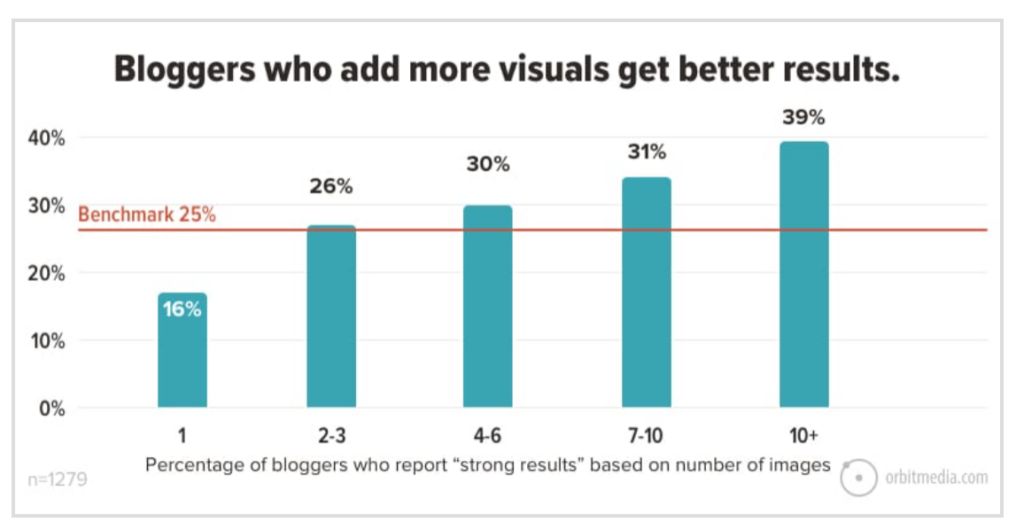
The best types of images to use:
- Charts and graphs
- Custom graphics or screenshots
- Stock photos (sparingly)
- Infographics
- Cartoons or comic-style visuals
Custom visuals are especially powerful. They take more time to create, but they increase shares, links, and time-on-page. If you can’t hire a designer, DIY tools make it easier than ever to create your own.

Formatting technique #2 – Create a custom layout: If you want your content to stand out, don’t rely on default blog formatting. A custom layout gives you the flexibility to improve visual hierarchy, highlight key info, and boost usability.
Custom layouts aren’t quick or cheap. But for cornerstone content—like definitive guides—they’re absolutely worth the investment.
What does a custom layout look like?
Most blog posts follow the same basic structure. That’s fine for everyday content—but limiting when you want to impress readers and Google alike.
In Backlinko’s link-building guide, Brian Dean uses a clean table of contents, attractive typography, and distinct backgrounds to break up content and improve navigation:
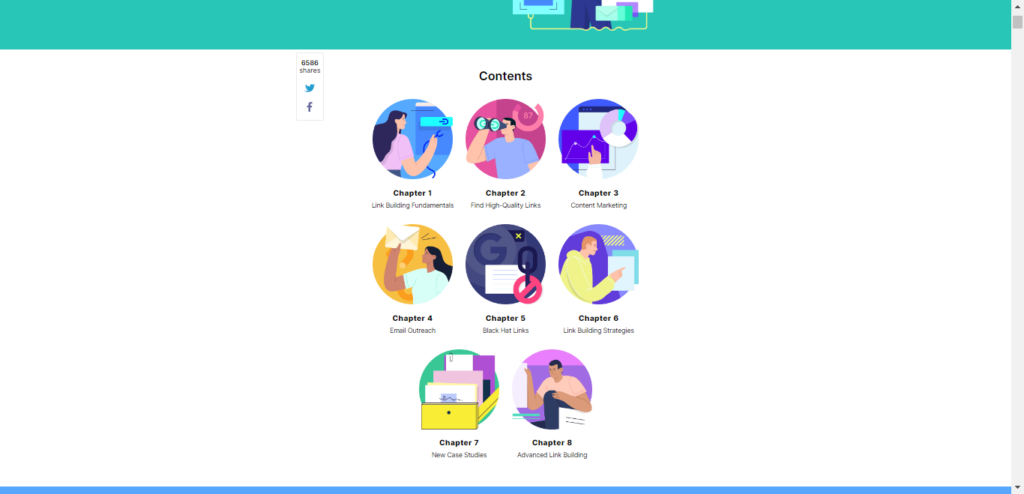
He also uses varying fonts, color blocks, and generous white space to keep the page visually engaging:
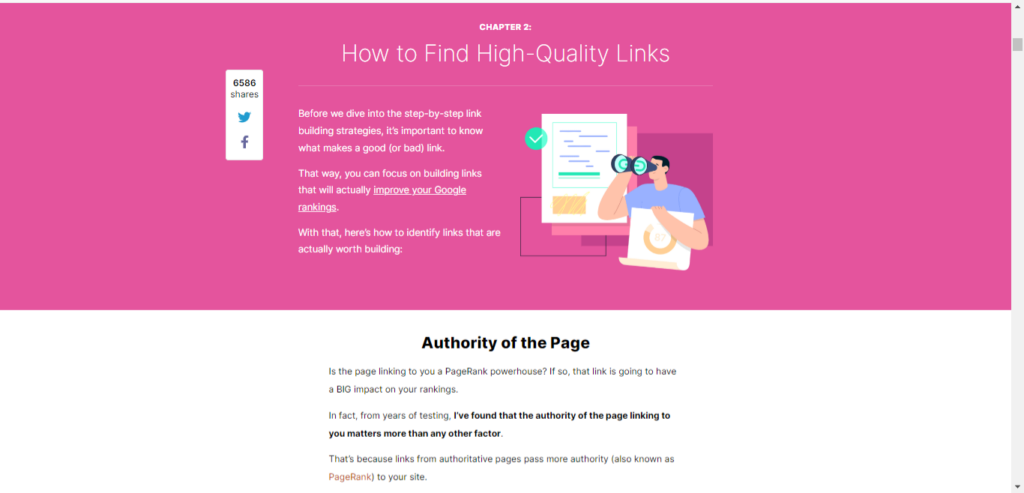
The result is an easy-to-navigate, high-authority feel:
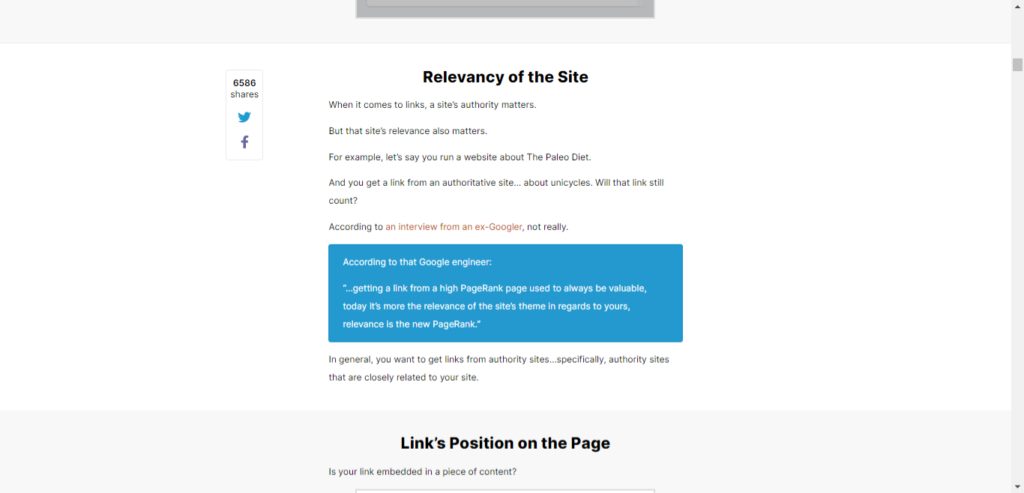
Custom layouts require time, money, or design skills—but they elevate good content into great content that’s easier to read, share, and rank.
Formatting technique #3 – Use lists wherever possible: Lists make content easier to skim. And readers love skimming.
Most visitors won’t read every word on the first pass. Lists help them extract value quickly, then decide what to read in depth.
Why lists work:
- They’re easier to scan quickly
- They chunk information into bite-sized pieces
- They reduce the need for long-winded explanations
Formatting technique #4 – Structure for maximum readability: Your content needs a clear visual hierarchy. Not just for SEO—but for user experience.
The easier it is to scan your content, the more likely readers will engage with it. This is where strong use of headings and subheadings makes a big difference.
Use H2s for main sections and H3s for sub-points. This hierarchy makes scanning faster and ensures that important takeaways aren’t lost in long blocks of text.
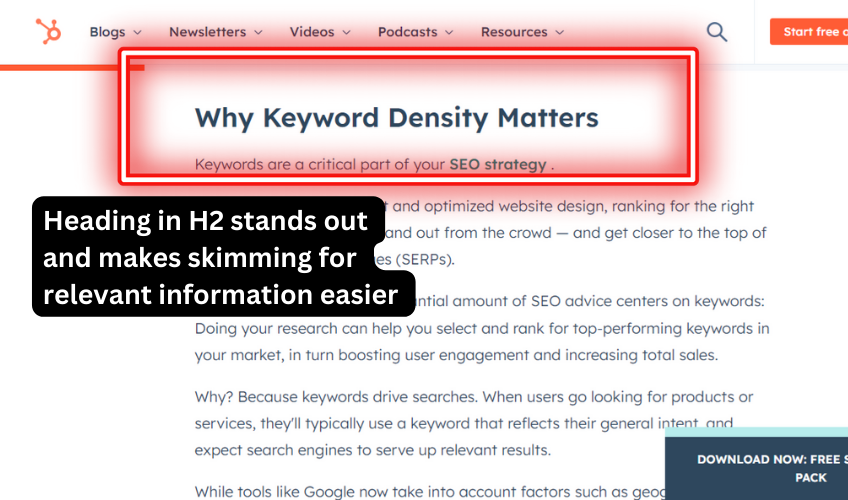
At Quick Sprout, we go even further—using spacing and design tweaks to make each subheading stand out even more. Otherwise, if all headings look the same, readers may miss key transitions or ideas.
Sometimes, a simple formatting change—like a bold callout box or custom blockquote—can break monotony and highlight key insights.
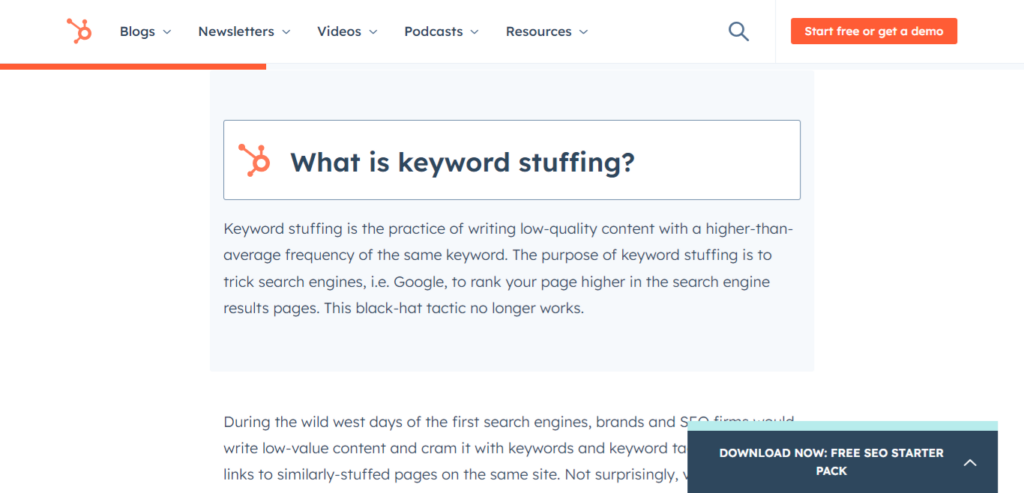
These design enhancements may seem minor—but they significantly improve user experience and keep readers on the page longer.
4. Give them something they can believe in
Blogs used to be personal diaries. Today, anyone can start a blog and claim to be an expert—even if they’re not.
That means readers are constantly asking: “Is this legit?”
Google wants to rank content that’s not only helpful—but credible. In 2026, credibility is central to search success.
You can boost credibility in two ways:
Option #1 – Interview or cite experts: If you’re not an authority in a niche (e.g., nutrition), build authority by quoting those who are.
Example: Instead of pretending to be a certified dietitian, reach out to one. Interview them. Use their insights. This boosts trust with readers and supports E-E-A-T (experience, expertise, authority, trustworthiness).
Look at Entrepreneur on Fire. John Lee Dumas launched with zero name recognition. But by interviewing successful entrepreneurs, he borrowed their credibility—and built his own along the way.
You can do the same. Until your name alone carries weight, use expert voices to lend strength to your content.
Option #2 – Support every claim with data: Nothing builds trust like cold, hard numbers. Whenever you make a claim, back it up with a source.
We try to support nearly every statement in our posts with stats, links, or examples. Yes, it takes more effort—but it results in content people actually trust.

The easiest way to find relevant stats? Google “[your topic] + statistics.”
If you’re in marketing, SaaS, or health—there are thousands of reputable stats available. Use them. Link them. Build trust.
For niche content, drill down even further. Writing about content marketing? Look up “content marketing statistics 2026.” You’ll likely find dozens of great sources.
Option #3 – Increase transparency: Add clear author bios, “Reviewed by” lines for expert checks (especially on YMYL topics), and a short methodology note when you cite your own research. Transparency signals quality.
5. Give readers control in complex situations
Your audience isn’t one-size-fits-all. Even if they share a common interest, they differ in experience levels, time constraints, learning preferences, and expectations.
Beyond writing great content, giving readers more control over how they engage with it increases satisfaction—which, in turn, helps your rankings.
Tactic #1 – Offer content in multiple formats: Some people love reading. Others prefer visuals or audio. Instead of choosing one format, offer options.
We often publish long-form guides alongside infographics. You could also embed videos, record audio summaries, or offer downloadable PDFs for offline access.
For example, in this Backlinko post, an infographic enhances a written guide—catering to both visual and textual learners.
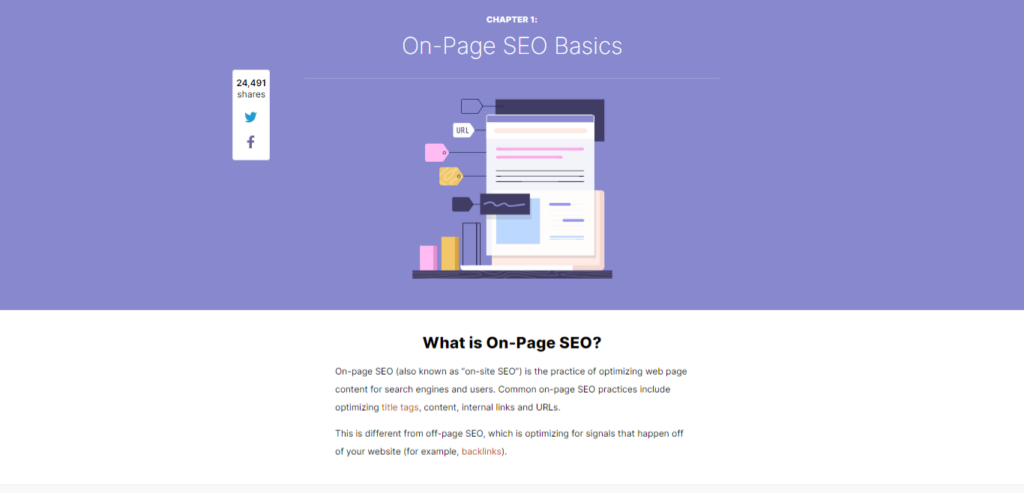
You can even gate downloadable PDFs behind a share or email opt-in. It’s a fair trade if the content is valuable.
Tactic #2 – Include a table of contents: People scan for the parts they care about. Why not help them skip to it instantly?
Wikipedia is a well-known example of scannable structure with a simple, clickable table of contents—proof that clarity beats flash.
You can replicate this using a WordPress plugin like Easy Table of Contents or create a more visual version for extra engagement.
In this post, a graphic table of contents elevates the reading experience even further.

Readers love options—and this creates a strong first impression while improving usability.
Tactic #3 – Let users filter massive lists: Massive list posts can be overwhelming. That’s why interactive filtering features are so valuable.
Take Jon Cooper’s famous list of SEO tactics. With over 150 strategies, it could easily overwhelm users—so he added a filtering system.

Readers can check boxes to filter by time investment, dependencies, or value—instantly customizing the post to their needs.
While this requires custom development, it’s worth considering for long-form content that tries to serve many different user scenarios.
Conclusion
Ranking #1 in search results isn’t easy—but that’s exactly why it’s valuable. To earn that top spot, your content needs to be the best answer on the internet for that query.
Think of every article you publish as an investment. The more time and effort you put in now, the more you’ll get in return through traffic, links, and leads.
Just know that results take time. You won’t hit 100K monthly visitors overnight—but with consistent publishing and strategic improvements, it’s possible.
And don’t pick just one strategy from this guide—combine them to build powerful, human-first, search-optimized content.
Think about your typical Quick Sprout article:
- Is it long and in-depth? – yes
- Is it clear, simple, and actionable? – yes
- Is it designed for readability and user-friendliness? – yes
- Is it supported by expert insights and data? – yes
- Does it offer multiple ways to engage? – sometimes (could be improved)
- Does it demonstrate first-hand experience and unique takeaways? – aim for yes
We consistently check these boxes. That’s how we create content that doesn’t just compete—but deserves to rank #1.
